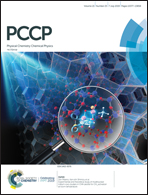Temperature and isotope effects in the reaction of CH3CHOO with methanol†
Abstract
Carbonyl oxides, also known as Criegee intermediates, are generated from ozonolysis of unsaturated hydrocarbons in the atmosphere. Alcohols are often used as a scavenger of the Criegee intermediates in laboratory studies. In this work, the reaction kinetics of CH3CHOO with methanol vapor was investigated at various temperatures, pressures, and isotopic substitutions using time-resolved UV absorption spectroscopy. The observed rate coefficients of the reaction of anti-CH3CHOO with methanol show a linear dependence on [CH3OH]. The bimolecular rate coefficient was determined to be k1Ha = (4.8 ± 0.5) × 10−12 cm3 s−1 at 298 K and 250 Torr with a negative activation energy Ea = −2.8 ± 0.3 kcal mol−1 for T = 288–315 K [k(T) = A exp(−Ea/RT)]. For the reaction of syn-CH3CHOO with methanol vapor, the observed rate coefficients show a quadratic dependence on [CH3OH], indicating that two methanol molecules participate in the reaction. The termolecular rate coefficient was determined to be k2Hs = (8.0 ± 1.0) × 10−32 cm6 s−1 at 298 K and 250 Torr with a strong negative temperature dependence (Ea = −13.2 ± 0.3 kcal mol−1) at 273–323 K. No significant pressure effect was observed at 250–760 Torr. A kinetic isotope effect, k2Hs/k2Ds = 2.5, was observed by changing CH3OH to CH3OD. Quantum chemistry and transition state theory calculations suggest that the observed isotope effect is mainly attributed to the changes of the vibrational zero-point energies and partition functions while tunneling plays a very minor role. The reaction of syn-CH3CHOO with one CH3OH molecule was not observed in the studied concentration range.



 Please wait while we load your content...
Please wait while we load your content...